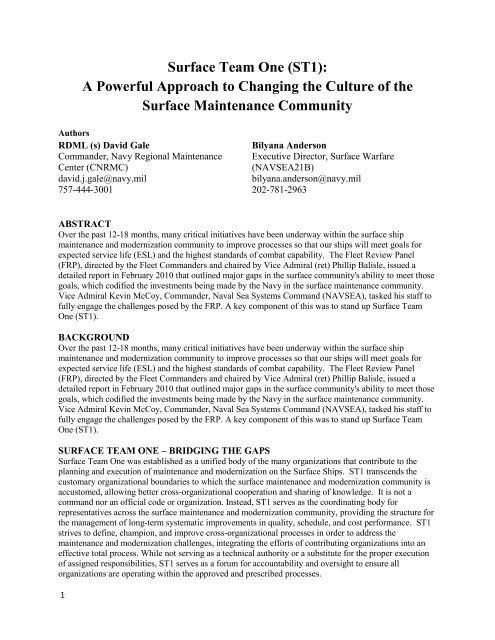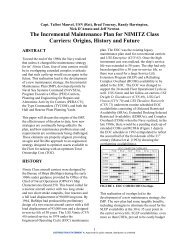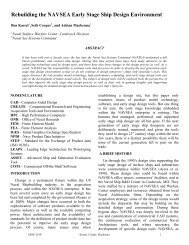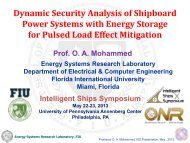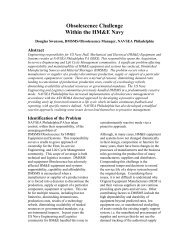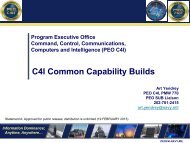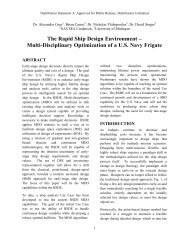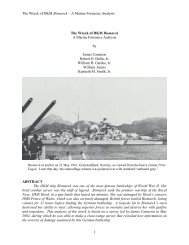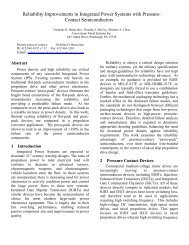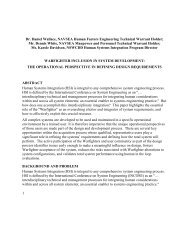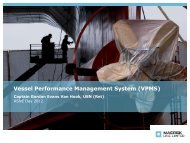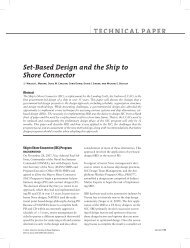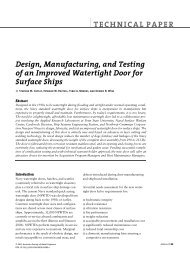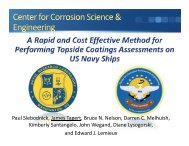Surface Team One (ST1): A Powerful Approach to Changing the ...
Surface Team One (ST1): A Powerful Approach to Changing the ...
Surface Team One (ST1): A Powerful Approach to Changing the ...
You also want an ePaper? Increase the reach of your titles
YUMPU automatically turns print PDFs into web optimized ePapers that Google loves.
1<br />
<strong>Surface</strong> <strong>Team</strong> <strong>One</strong> (<strong>ST1</strong>):<br />
A <strong>Powerful</strong> <strong>Approach</strong> <strong>to</strong> <strong>Changing</strong> <strong>the</strong> Culture of <strong>the</strong><br />
<strong>Surface</strong> Maintenance Community<br />
Authors<br />
RDML (s) David Gale<br />
Commander, Navy Regional Maintenance<br />
Center (CNRMC)<br />
david.j.gale@navy.mil<br />
757-444-3001<br />
Bilyana Anderson<br />
Executive Direc<strong>to</strong>r, <strong>Surface</strong> Warfare<br />
(NAVSEA21B)<br />
bilyana.anderson@navy.mil<br />
202-781-2963<br />
ABSTRACT<br />
Over <strong>the</strong> past 12-18 months, many critical initiatives have been underway within <strong>the</strong> surface ship<br />
maintenance and modernization community <strong>to</strong> improve processes so that our ships will meet goals for<br />
expected service life (ESL) and <strong>the</strong> highest standards of combat capability. The Fleet Review Panel<br />
(FRP), directed by <strong>the</strong> Fleet Commanders and chaired by Vice Admiral (ret) Phillip Balisle, issued a<br />
detailed report in February 2010 that outlined major gaps in <strong>the</strong> surface community's ability <strong>to</strong> meet those<br />
goals, which codified <strong>the</strong> investments being made by <strong>the</strong> Navy in <strong>the</strong> surface maintenance community.<br />
Vice Admiral Kevin McCoy, Commander, Naval Sea Systems Command (NAVSEA), tasked his staff <strong>to</strong><br />
fully engage <strong>the</strong> challenges posed by <strong>the</strong> FRP. A key component of this was <strong>to</strong> stand up <strong>Surface</strong> <strong>Team</strong><br />
<strong>One</strong> (<strong>ST1</strong>).<br />
BACKGROUND<br />
Over <strong>the</strong> past 12-18 months, many critical initiatives have been underway within <strong>the</strong> surface ship<br />
maintenance and modernization community <strong>to</strong> improve processes so that our ships will meet goals for<br />
expected service life (ESL) and <strong>the</strong> highest standards of combat capability. The Fleet Review Panel<br />
(FRP), directed by <strong>the</strong> Fleet Commanders and chaired by Vice Admiral (ret) Phillip Balisle, issued a<br />
detailed report in February 2010 that outlined major gaps in <strong>the</strong> surface community's ability <strong>to</strong> meet those<br />
goals, which codified <strong>the</strong> investments being made by <strong>the</strong> Navy in <strong>the</strong> surface maintenance community.<br />
Vice Admiral Kevin McCoy, Commander, Naval Sea Systems Command (NAVSEA), tasked his staff <strong>to</strong><br />
fully engage <strong>the</strong> challenges posed by <strong>the</strong> FRP. A key component of this was <strong>to</strong> stand up <strong>Surface</strong> <strong>Team</strong><br />
<strong>One</strong> (<strong>ST1</strong>).<br />
SURFACE TEAM ONE – BRIDGING THE GAPS<br />
<strong>Surface</strong> <strong>Team</strong> <strong>One</strong> was established as a unified body of <strong>the</strong> many organizations that contribute <strong>to</strong> <strong>the</strong><br />
planning and execution of maintenance and modernization on <strong>the</strong> <strong>Surface</strong> Ships. <strong>ST1</strong> transcends <strong>the</strong><br />
cus<strong>to</strong>mary organizational boundaries <strong>to</strong> which <strong>the</strong> surface maintenance and modernization community is<br />
accus<strong>to</strong>med, allowing better cross-organizational cooperation and sharing of knowledge. It is not a<br />
command nor an official code or organization. Instead, <strong>ST1</strong> serves as <strong>the</strong> coordinating body for<br />
representatives across <strong>the</strong> surface maintenance and modernization community, providing <strong>the</strong> structure for<br />
<strong>the</strong> management of long-term systematic improvements in quality, schedule, and cost performance. <strong>ST1</strong><br />
strives <strong>to</strong> define, champion, and improve cross-organizational processes in order <strong>to</strong> address <strong>the</strong><br />
maintenance and modernization challenges, integrating <strong>the</strong> efforts of contributing organizations in<strong>to</strong> an<br />
effective <strong>to</strong>tal process. While not serving as a technical authority or a substitute for <strong>the</strong> proper execution<br />
of assigned responsibilities, <strong>ST1</strong> serves as a forum for accountability and oversight <strong>to</strong> ensure all<br />
organizations are operating within <strong>the</strong> approved and prescribed processes.
Stakeholders in <strong>ST1</strong> include <strong>the</strong> Chief of Naval Operations Staff (OPNAV), Fleet Commanders’ staffs,<br />
Type Commanders’ staffs (TYCOMs), NAVSEA, and every surface ship. A common goal exists across<br />
all stakeholders -- <strong>to</strong> improve current readiness and <strong>to</strong> meet <strong>the</strong> ship’s ESL. Each of <strong>the</strong>se<br />
commands/organizations plays its own part in achieving this goal, and each is critical <strong>to</strong> <strong>the</strong> whole.<br />
Because it is common for organizations <strong>to</strong> maintain <strong>the</strong>ir principal focus on day-<strong>to</strong>-day efforts in very<br />
dynamic Navy workplaces, it is important <strong>to</strong> have a structure that drives opportunities <strong>to</strong> share<br />
information across traditional boundaries and account for decisions or actions that may affect o<strong>the</strong>rs’<br />
efforts. <strong>ST1</strong> provides that structure.<br />
The surface community’s interdependency is most visible in <strong>the</strong> organizational ―hand-offs‖ – those <strong>to</strong>uch<br />
points where one command turns a product over <strong>to</strong> ano<strong>the</strong>r – and <strong>the</strong>re are many. An example of <strong>the</strong>se<br />
interdependencies is found in routinely scheduled ship availabilities. Multi-Ship, Multi-Option (MSMO)<br />
contrac<strong>to</strong>rs conduct <strong>the</strong> scheduled ship modernization and repair. The MSMO contract strategy is<br />
developed by NAVSEA21, who has a reporting responsibility <strong>to</strong> Navy leadership. Regional Maintenance<br />
Centers (RMCs) execute contracts with <strong>the</strong> selected MSMO contracting partners and oversee <strong>the</strong>ir efforts<br />
as <strong>the</strong> Navy Supervisory Authority. Work conducted by <strong>the</strong> MSMO contrac<strong>to</strong>rs is funded by <strong>the</strong><br />
TYCOMs and <strong>the</strong> NAVSEA Program Office. Work execution and completion is tracked and reported<br />
through <strong>to</strong> <strong>the</strong> TYCOMs, Fleet Commanders, NAVSEA and OPNAV. The many stakeholders range<br />
from <strong>the</strong> deckplates <strong>to</strong> Washing<strong>to</strong>n, DC.<br />
This is just one example of <strong>the</strong> complexity of <strong>the</strong> surface community’s organizational hand-offs, which<br />
involve many people and many commands. Each hand-off is an opportunity for success… or for failure.<br />
The power of <strong>the</strong> <strong>ST1</strong> body resides in its ability <strong>to</strong> align separate maintenance organizations, allowing<br />
<strong>the</strong>m <strong>to</strong> operate in a single integrated effort <strong>to</strong> execute approved processes.<br />
KNOWLEDGE MANAGEMENT SYSTEM<br />
An essential benefit from <strong>ST1</strong> is knowledge sharing. <strong>ST1</strong> has established a Knowledge Management<br />
(KM) system for <strong>the</strong> surface community.<br />
If knowledge is power, <strong>the</strong>n it needs <strong>to</strong> be exploited <strong>to</strong> <strong>the</strong> fullest extent for <strong>the</strong> most powerful Navy on<br />
earth. Note that knowledge is ei<strong>the</strong>r explicit— such as manuals, blueprints and instructions, or tacit —<br />
what people know in <strong>the</strong>ir heads. Most references suggest that only about 20% of knowledge is explicit<br />
while <strong>the</strong> remaining 80% is tacit. Consequently, sharing tacit knowledge is where <strong>the</strong> real opportunity for<br />
learning resides and <strong>the</strong> point at which <strong>the</strong> community can leverage <strong>the</strong> power of our stakeholders <strong>to</strong><br />
benefit our Navy. Knowledge sharing allows project teams and community members better achieve<br />
maintenance and modernization goals on a small or large scale, but most importantly, as a network.<br />
<strong>ST1</strong> provides a platform for <strong>the</strong> oversight and management of surface maintenance knowledge processes,<br />
developing ―Knowledge Managers‖ who provide <strong>the</strong> expertise, <strong>to</strong>ols, and on-line web-supported systems<br />
essential for <strong>the</strong> effective capture and sharing of community knowledge across <strong>the</strong> stakeholder<br />
organizations.<br />
Some of <strong>the</strong> benefits from operating with a well-established KM System are that it:<br />
� takes advantage of existing expertise and experience;<br />
� promotes standard, repeatable processes and procedures;<br />
� allows re-use of <strong>the</strong> organization’s best problem-solving experiences;<br />
� provides methods, <strong>to</strong>ols, templates, techniques and examples.<br />
2
With every group or community <strong>the</strong>re are challenges, and those with a KM system in place are better<br />
equipped <strong>to</strong> address <strong>the</strong>m by avoiding:<br />
� repetitive mistakes;<br />
� reinventing <strong>the</strong> wheel;<br />
� inadequate standards;<br />
� lack of knowledge resources - ―we don’t know what we know‖.<br />
Opportunities always exist for improvement. A community operating with KM System is able <strong>to</strong><br />
recognize opportunities when <strong>the</strong>y arise and understand how and in what construct one can take action <strong>to</strong><br />
improve upon <strong>the</strong>m. Below are some areas where opportunities for improvement exist:<br />
� Effectiveness: taking advantage of existing expertise and experience;<br />
� Learning: communicating important information widely and quickly. An informed workforce can<br />
act in accordance with <strong>the</strong> leadership’s strategy and direction;<br />
� Repeatability: providing standard processes, procedures, methods, <strong>to</strong>ols, templates, techniques<br />
and examples. The result is consistent products and services of high quality;<br />
� Transportability: making scarce expertise widely available. In o<strong>the</strong>r words, key knowledge from<br />
one part of <strong>the</strong> organization can be applied when needed by ano<strong>the</strong>r organization, which can<br />
make a difference in saving money. satisfying a cus<strong>to</strong>mer, or resolving a crisis;<br />
� Efficiency: accelerating product or capability deliveries <strong>to</strong> cus<strong>to</strong>mers;<br />
� Leveraging: Bureaucracies are cumbersome, but <strong>the</strong>re’s lots of information in <strong>the</strong>m. Sharing<br />
information enables larger organizations <strong>to</strong> use <strong>the</strong>ir size <strong>to</strong> <strong>the</strong>ir advantage;<br />
� Reliability: an organization’s best problem-solving experiences need <strong>to</strong> be re-usable;<br />
� Innovation: invention, process improvement, cycle time reduction and creative new ways of<br />
doing things help stimulate growth and make an organization stronger.<br />
Reference: Extracted from “Implementing a Successful KM Program” by Stan Garfield, author of <strong>the</strong> Ark<br />
Group Report.<br />
CHANGING THE CULTURE OF SURFACE SHIP MAINTENANCE AND<br />
MODERNIZATION<br />
<strong>Changing</strong> <strong>the</strong> way business is done within a large organization frequently requires a change in culture.<br />
Moving surface ship maintenance and modernization in<strong>to</strong> a new culture of performance excellence and<br />
driving new practices will require a significant change in organizational mindset, along with strong<br />
leadership. When <strong>ST1</strong> was established, <strong>the</strong> structure was designed <strong>to</strong> account for culture change and<br />
address organizational challenges and mindsets, <strong>ST1</strong> is a deliberately planned effort <strong>to</strong> take steps required<br />
<strong>to</strong> establish a new culture – one that incorporates trust, knowledge sharing, and a desire <strong>to</strong> find new and<br />
better ways <strong>to</strong> maintain and modernize our surface ships.<br />
The <strong>ST1</strong> Construct<br />
<strong>ST1</strong> is made up of various levels of effort. Figure 1 below shows <strong>the</strong> basic structure of <strong>ST1</strong>, and each<br />
block is described in greater detail below. Note that this construct is continuously morphing <strong>to</strong> best fit <strong>the</strong><br />
requirement of <strong>the</strong> overall surface maintenance and modernization community as new requirements and<br />
process gaps are identified.<br />
3
4<br />
Figure 1. <strong>ST1</strong> Basic Structure<br />
Executive Steering Committee<br />
<strong>ST1</strong>’s oversight is <strong>the</strong> Executive Steering Committee (ESC). This senior level (O-7 / O-6, GS-15 / GS-<br />
14) body of representatives from <strong>the</strong> many Navy maintenance and modernization commands manages<br />
community priorities and provides guidance and support for <strong>the</strong> many initiatives being put in<strong>to</strong> place.<br />
The ESC is Co-Chaired by NAVSEA21B and CNRMC with Principal Membership made up of <strong>the</strong><br />
TYCOM N43s and Fleet N43s. Additional Membership <strong>to</strong> <strong>the</strong> ESC includes OPNAV N43, NAVSEA,<br />
Navy Regional Maintenance Center (NRMC), SURFMEPP, Navy <strong>Surface</strong> Warfare Centers (NSWC) in<br />
Philadelphia and Port Hueneme, Space and Naval Warfare Systems Command (SPAWAR), and <strong>the</strong><br />
Program Executive Office for Integrated Warfare Systems (PEO IWS).<br />
The ESC supports maintenance and modernization efforts by providing guidance and a common vision,<br />
empowering support efforts <strong>to</strong> accomplish goals, and in assisting organizations in driving changes.<br />
Additionally, <strong>the</strong> ESC serves as <strong>the</strong> ―executive memory‖ for <strong>the</strong> surface maintenance and modernization<br />
community, <strong>to</strong> make certain that <strong>the</strong> rationale for decisions made and <strong>the</strong> impact <strong>the</strong>y had collected in <strong>the</strong><br />
knowledge data bank.<br />
The Life Cycle Management Group is a sub-set of <strong>the</strong> ESC and oversees and executes strategies <strong>to</strong><br />
improve engineering, logistics requirements and funding for Life Cycle Sustainment. The LCMG<br />
collaborates on current year execution requirements, improves readiness and ensures requirements and<br />
goals match achieved readiness levels. The group also considers future year maintenance, sustainment,<br />
and modernization requirements.
Key Process Focus Areas – <strong>Surface</strong> Ship Readiness Initiatives<br />
In early 2010, five major initiatives were born out of an analysis comparing surface ship maintenance<br />
processes <strong>to</strong> those for <strong>the</strong> carrier and submarine communities. This analysis resulted in development of a<br />
<strong>Surface</strong> Ship Maintenance, Modernization, and Sustainment End-<strong>to</strong>-End Process Map. By mapping out<br />
<strong>the</strong> community’s processes, distinct gaps in <strong>the</strong> plan were identified and <strong>the</strong> culmination of <strong>the</strong>ir work<br />
became known as <strong>the</strong> ―<strong>Surface</strong> Ship Readiness Initiatives‖ (SSRIs) or <strong>the</strong> ―5 Big Rocks‖. The SSRIs<br />
included:<br />
� Transitioning <strong>the</strong> <strong>Surface</strong> Ship Life Cycle Management Activity (SSLCM) <strong>to</strong> <strong>Surface</strong> Ship<br />
Maintenance Engineering Planning Program (SURFMEPP),<br />
� Common Assessments Policy,<br />
� Availability Execution and Work Certification,<br />
� Sustainment Program,<br />
� RMC Capabilities and Capacity.<br />
The SSRIs are key contribu<strong>to</strong>rs <strong>to</strong> <strong>the</strong> <strong>ST1</strong> priorities, and <strong>the</strong>ir objectives are coordinated and led by<br />
various stakeholder commands on <strong>the</strong> <strong>ST1</strong> ESC. More specific objectives and accomplishments of <strong>the</strong>se<br />
initiatives are detailed later in this paper.<br />
Increasing Power through Knowledge Sharing Networks<br />
<strong>ST1</strong> has established several Knowledge Sharing Networks (KSNs), which are cross-organizational groups<br />
focused on specific practices ra<strong>the</strong>r than specific tasks or assignments. The goal is <strong>to</strong> manage <strong>the</strong><br />
evolution of those processes over time. Essentially, a KSN seeks <strong>to</strong>:<br />
� share new ideas, lessons learned, proven practices, insights, and practical suggestions;<br />
� innovate through brains<strong>to</strong>rming, building on each o<strong>the</strong>r's ideas, and keeping informed on<br />
emerging developments;<br />
� reuse solutions through asking and answering questions, applying shared insights, and retrieving<br />
posted material;<br />
� collaborate through threaded discussions, conversations, and interactions;<br />
� learn from o<strong>the</strong>r members of <strong>the</strong> community; from invited guest speakers about successes,<br />
failures, case studies, and new trends; and through men<strong>to</strong>ring.<br />
Under <strong>the</strong> <strong>ST1</strong> construct, each KSN aligns overarching priorities and objectives of <strong>the</strong> community, gains<br />
assistance from <strong>the</strong> ESC in overcoming any obstacles, and communicates suggestions for process<br />
improvement. Additionally, <strong>the</strong> KSNs share information and knowledge across <strong>the</strong> <strong>Surface</strong> Navy<br />
community. Each KSN is led by a Process Master (PM) and also has an ESC Sponsor who champions<br />
<strong>the</strong> efforts of <strong>the</strong> KSNs <strong>to</strong> <strong>the</strong> ESC. In addition, each KSN’s membership is made up of subject matter<br />
experts from <strong>the</strong> community. More specific objectives and accomplishments of <strong>the</strong>se initiatives are<br />
detailed below.<br />
IMPACTING THE SURFACE COMMUNITY CULTURE VIA COLLABORATIVE<br />
POLICY AND PROCESS DEVELOPMENT<br />
Using <strong>the</strong> powerful <strong>to</strong>ols in knowledge management as described above, and a strong stakeholder<br />
construct that allows for both ―<strong>to</strong>p-down‖ and ―bot<strong>to</strong>m up‖ execution of work, <strong>ST1</strong> has been established<br />
as <strong>the</strong> way business is conducted in <strong>the</strong> surface community. This is a change in <strong>the</strong> overall culture of <strong>the</strong><br />
community – <strong>the</strong> results of which, in its short tenure, are plenty. To drive <strong>to</strong>wards strong change in <strong>the</strong><br />
way in which <strong>the</strong> community conducts business, organizational changes have been initiated with<br />
collaborative development of revised policies and processes.<br />
5
End-<strong>to</strong>-End Availability Planning Cycle<br />
The end-<strong>to</strong>-end availability planning cycle was designed <strong>to</strong> drive improvements <strong>to</strong> surface ship material<br />
condition. It is a comprehensive process from <strong>the</strong> development of, execution of, and feedback in<strong>to</strong> <strong>the</strong><br />
requirements. Mapping out <strong>the</strong> availability planning cycle with technical rigor is <strong>the</strong> foundation of <strong>the</strong><br />
bridge required <strong>to</strong> address <strong>the</strong> process gaps. The SSRIs and KSNs impact <strong>the</strong> overall end-<strong>to</strong>-end process<br />
map in various manners, and <strong>the</strong> availability planning cycle is a big piece of that.<br />
6<br />
End-<strong>to</strong>-End Availability Planning Cycle<br />
Avail. Close Out<br />
Deferral Le er<br />
Assessment<br />
Condi on<br />
Plan Long Range Requirements in<strong>to</strong> Availabili es<br />
Class Maintenance<br />
Plan (CMP)<br />
Technical<br />
Founda on Paper<br />
(Class No onal<br />
LRMS)<br />
Execute Availability<br />
Ship Sheets<br />
(Ship specific<br />
LRMS)<br />
Technical Reqts Class Reqts ($) Specific Ship Reqts<br />
($, Schedule)<br />
Availability Work<br />
Package (AWP)<br />
Integrate, Execute, Document and Feedback<br />
Figure 2. End-<strong>to</strong>-End Availability Planning Cycle<br />
Baseline<br />
Availability Work<br />
Package (BAWP)<br />
Plan FRP Cycle<br />
Document &<br />
Feedback Execute<br />
Integrate Package Plan Availability<br />
Assessment Results<br />
Ship CSMP<br />
Moderniza on<br />
Balancing Technical, Opera onal, and Financial Risk <strong>to</strong> increase Ao and decrease $$<br />
SURFMEPP u lized best prac ces from SUBMEPP & CPA<br />
The DDG 51 Class was <strong>the</strong> first <strong>to</strong> enter this revised end-<strong>to</strong>-end availability cycle, and 29 DDGs are on<br />
schedule <strong>to</strong> complete <strong>the</strong> cycle in FY12. All surface ships are expected <strong>to</strong> complete <strong>the</strong> end-<strong>to</strong>-end<br />
availability planning cycle by January 2017.<br />
Transition <strong>to</strong> SURFMEPP (a <strong>Surface</strong> Ship Readiness Initiative).<br />
In order <strong>to</strong> accomplish <strong>the</strong> planning cycle, as laid out in Figure 2, it was necessary for <strong>the</strong> SSLCM<br />
Activity <strong>to</strong> expand <strong>to</strong> SURFMEPP with newly defined requirements and functions. In November 2010,<br />
SSLCM s<strong>to</strong>od down and SURFMEPP was established in its place, and since that time <strong>the</strong> command has<br />
already accomplished a great deal in contributing <strong>to</strong> <strong>the</strong> surface maintenance and modernization<br />
community. Some of <strong>the</strong>se accomplishments are identified below, and all are clearly a contributing fac<strong>to</strong>r<br />
<strong>to</strong> <strong>the</strong> overall <strong>ST1</strong> community priorities, which include: getting <strong>the</strong> maintenance requirement right for<br />
both current readiness and for <strong>the</strong> overall life cycle, and efficiently and effectively executing <strong>the</strong> surface<br />
ship annual maintenance plan.<br />
� The Technical Foundation Papers (TFP) have been developed and completed on four ship classes,<br />
including DDG 51, CG 47, LSD 41/49, and LHD 1.<br />
� The LPD-17 Class TFP has been completed and is in review.<br />
� The MCM Class TFP is in progress with an estimated completion date of September 2011.<br />
� Technical studies and analyses have been completed on LCC-19 Extended Service Life (ESL),<br />
LCS Class, DDG-1000 Class, and <strong>the</strong> 32/8 FRP cycle review.<br />
� 46 Baseline Availability Work Packages (BAWP) across 4 Ship Classes have been delivered.<br />
� 21 DDG-21 BAWPs have been delivered <strong>to</strong> <strong>the</strong> TYCOMs.<br />
� Thousands of man-days have been added in<strong>to</strong> <strong>the</strong> surface maintenance requirement.
Additionally, SURFMEPP is leading <strong>the</strong> day-<strong>to</strong>-day operations of <strong>the</strong> BAWP-AWP KSN. The BAWP-<br />
AWP hand-off process is complex due <strong>to</strong> <strong>the</strong> number of organizations and individuals involved with<br />
managing various pieces of <strong>the</strong> products. SURFMEPP owns and manages <strong>the</strong> BAWP, while <strong>the</strong> Type<br />
Commander owns <strong>the</strong> AWP (an output of <strong>the</strong> BAWP), and <strong>the</strong> RMCs execute <strong>the</strong> AWP in an availability.<br />
The KSN was established <strong>to</strong> clearly define <strong>the</strong> roles and responsibilities associated with <strong>the</strong> product<br />
turnover as well as develop a ―desk guide‖ <strong>to</strong> assist in communicating <strong>the</strong> overall effort. As <strong>the</strong> process<br />
continues <strong>to</strong> be executed on additional availabilities, <strong>the</strong> KSN will capture and apply lessons learned.<br />
As SURFMEPP continues <strong>to</strong> grow as an organization, it ensures connectivity of its many products <strong>to</strong> <strong>the</strong><br />
o<strong>the</strong>r stakeholder commands via <strong>the</strong> <strong>ST1</strong> construct. As an integral part of <strong>the</strong> <strong>ST1</strong> ESC, SURFMEPP<br />
interfaces with all <strong>the</strong> ESC organizations and leverages those relationships <strong>to</strong> ensure collaboration<br />
continues in <strong>the</strong> process and product development.<br />
Assessments (a <strong>Surface</strong> Ship Readiness Initiative)<br />
<strong>One</strong> of <strong>the</strong> five key gaps identified in <strong>the</strong> end-<strong>to</strong>-end process map was <strong>the</strong> lack of a common assessments<br />
policy. To address this, a SSRI was s<strong>to</strong>od up with <strong>the</strong> objective <strong>to</strong> integrate <strong>the</strong> assessments conducted by<br />
Ship's Force, TYCOMs, Board of Inspection and Survey, ISEA, American Bureau of Shipping (ABS),<br />
RMC, naval and private sec<strong>to</strong>r shipyards, and Planning Yard and Program Acquisition Resource Manager<br />
(PARM) in<strong>to</strong> a continuous effort that identifies, evaluates, and screens maintenance items for completion.<br />
The process:<br />
� takes in<strong>to</strong> account distance support and analysis <strong>to</strong>ols such as (Integrated Condition Assessment<br />
System (ICAS) and Operational Readiness Test System Tech Assist Remote Support (ORTSTARS);<br />
� yields an accurate and real time view of material condition that minimizes surprises and supports<br />
efficient budgeting and scheduling;<br />
� supports current readiness requirements and enable timely assessments <strong>to</strong> meet ESL requirements.<br />
To date, <strong>the</strong> Assessments SSRI has accomplished a great deal in its contribution <strong>to</strong> <strong>the</strong> overall surface<br />
community in <strong>the</strong> following manner:<br />
� Fostered <strong>the</strong> development of <strong>the</strong> TYCOM and CNRMC-issued common assessment policy <strong>to</strong><br />
formerly establish Total Ship Readiness Assessments (TSRA).<br />
� Issued CNRMC ―Coordination of Assessments‖ letter <strong>to</strong> all Program Executive Offices (PEOs).<br />
� Executed pilot assessments and obtained very positive results. TSRA results have fed <strong>the</strong><br />
SURFMEPP process <strong>to</strong> engineer work packages and reduce overall growth.<br />
The efforts of this group are enduring in that it has taken in<strong>to</strong> account <strong>the</strong> many stakeholder organizations<br />
required <strong>to</strong> pull <strong>to</strong>ge<strong>the</strong>r a common plan for a complex community. This SSRI is implementing change in<br />
<strong>the</strong> community culture by breaking through <strong>the</strong> ―s<strong>to</strong>ve pipe‖ structure and reaching out <strong>to</strong> ensure<br />
commonality and strong communication across <strong>the</strong> board.<br />
Availability Execution and Work Certification (a <strong>Surface</strong> Ship Readiness Initiative)<br />
The objective of this group has been <strong>to</strong> incorporate increased technical rigor, standard processes and<br />
formality in <strong>the</strong> execution of CNO availabilities. The focus is on five specific areas. They include:<br />
� Technical adjudication of growth and new work <strong>to</strong> ensure proper rigor is applied <strong>to</strong> growth and<br />
new work identified during technically mandated assessments or repairs.<br />
� Work certification <strong>to</strong> ensure all availability work is planned, executed, and tested as technically<br />
correct.<br />
� Integrated Test Plan Management <strong>to</strong> integrate all maintenance activity and ship’s force testing as<br />
well as <strong>to</strong> support availability certification.<br />
7
8<br />
� Event readiness <strong>to</strong> prepare standard pre-requisite templates and timelines for propulsion and C5I<br />
Production Completion Date (PCD) events.<br />
� Availability closeout <strong>to</strong> improve tracking and close-out of all availability completion issues,<br />
Integrated Logistics System (ILS) deliverables, and Safe-<strong>to</strong>-Operate Validation Testing (SOVT).<br />
This SSRI has implemented pilot processes on five availabilities and is collecting feedback from those<br />
pilot efforts <strong>to</strong> incorporate in<strong>to</strong> <strong>the</strong> process build. The result of this effort will be an instruction released<br />
by CNRMC for overall policy on availability execution and work certification that will also be<br />
incorporated in<strong>to</strong> <strong>the</strong> JFMM.<br />
Sustainment Program (a <strong>Surface</strong> Ship Readiness Initiative).<br />
To more formally integrate <strong>the</strong> many activities, programs, and initiatives that support <strong>the</strong> ship during<br />
periods between major CNO Availabilities, <strong>the</strong> Sustainment SSRI was tasked <strong>to</strong> address a variety of<br />
issues. The objective of this group has been <strong>to</strong> focus efforts on core functions and initiatives <strong>to</strong>:<br />
� Apply <strong>the</strong> Navy’s technical expertise (In-Service Engineering Agent (ISEA)/Life Cycle Manager<br />
(LCM)/Technical Warrant Holder (TWH)) <strong>to</strong> surface Navy maintenance and engineering issues;<br />
� Evaluate and improve system technical requirements including training, logistics documentation,<br />
and assessments;<br />
� Develop accurate system life-cycle strategies that ensure <strong>Surface</strong> Ships meet Expected Service<br />
Life (ESL) and reduce Total Ownership Cost (TOC);<br />
� Improve Fleet Readiness by providing core engineering support <strong>to</strong> resolve critical Fleet<br />
engineering, safety, corrosion and obsolescence issues;<br />
� Support surface ship maintenance and SURFMEPP efforts (Technical Foundation Papers).<br />
A great deal of collaboration must occur between stakeholder commands in order <strong>to</strong> accomplish <strong>the</strong>se<br />
objectives. Since its establishment, <strong>the</strong> Sustainment SSRI has engaged <strong>the</strong> <strong>ST1</strong> ESC <strong>to</strong> assist in reaching<br />
critical accomplishments, including:<br />
� Program Required Engineering/Program Required Logistics (PRE/PRL) dollars executed in FY11<br />
(approximately 24 million) used <strong>to</strong> initiate Life Cycle Sustainment Program.<br />
� 24 different systems being reviewed for sustainment and life cycle performance by In-Service<br />
Engineering Agents (ISEAs).<br />
� Achieving Service Life Program established, which has Instituted independent, third party review<br />
of <strong>Surface</strong> Ship material condition. Additionally, 29 baseline ship surveys will have been<br />
completed by <strong>the</strong> end of FY11.<br />
Corrosion Control Knowledge Sharing Network<br />
The primary purpose of <strong>the</strong> Corrosion Control KSN is <strong>to</strong> emphasize corrosion prevention, control, and<br />
abatement throughout <strong>the</strong> lifecycle of surface ships from design <strong>to</strong> decommissioning. This <strong>to</strong>tal lifecycle<br />
focus will not only help reduce corrosion related maintenance costs, but will also ensure our surface ships<br />
maintain <strong>the</strong>ir mission readiness and meet <strong>the</strong>ir expected service life (ESL). The KSN provides a singledup<br />
approach <strong>to</strong> evaluating corrosion issues facing <strong>the</strong> fleet, maintaining a reporting structure/mechanism<br />
<strong>to</strong> address <strong>the</strong>se issues, prioritizing and selecting mitigation efforts for investment, and coordinating and<br />
co-sponsoring budget submissions <strong>to</strong> reduce <strong>the</strong> cost of corrosion related maintenance <strong>to</strong> <strong>the</strong> Fleet.<br />
The KSN is comprised of members from <strong>the</strong> opera<strong>to</strong>r, maintenance execution, maintenance planning,<br />
engineering, research and development, and program management organizations <strong>to</strong> ensure that a multidisciplined,<br />
comprehensive approach is followed in serving <strong>the</strong> fleet.
<strong>Surface</strong> Metrics Knowledge Sharing Network<br />
The <strong>Surface</strong> Metrics KSN has established a community of metrics professionals with several key<br />
objectives. The team reduces <strong>the</strong> duplication of efforts currently experienced in both <strong>the</strong> development<br />
and implementation of metrics, will develop a central library of existing metrics and resources, and create<br />
metrics standards in surface ship maintenance for consistency in reporting.<br />
This KSN includes membership from <strong>the</strong> TYCOM N43s, CNRMC and <strong>the</strong> RMCs, NAVSEA21, and<br />
several o<strong>the</strong>r organizations. Additionally, on a quarterly basis, <strong>the</strong> KSN offers a community meeting,<br />
which provides an opportunity for all members of <strong>the</strong> community, including industry partners, <strong>to</strong><br />
participate and share knowledge with one ano<strong>the</strong>r.<br />
The above initiatives and networks are examples of <strong>the</strong> many ways <strong>ST1</strong> is bridging <strong>the</strong> gaps in <strong>the</strong> surface<br />
maintenance and modernization community processes and policies. Utilizing knowledge management<br />
<strong>to</strong>ols and resources, <strong>the</strong>se teams are working across organizations and ensuring collaborative approaches<br />
<strong>to</strong> getting business done.<br />
DEVELOPING THE COMMUNITY’S MAINTENANCE PROFESSIONALS TO<br />
IMPACT CULTURE CHANGE<br />
In order <strong>to</strong> better support <strong>the</strong> current and material readiness of <strong>the</strong> <strong>Surface</strong> Fleet, <strong>the</strong> maintenance and<br />
modernization community professionals must be a strong and supported part of <strong>the</strong> <strong>ST1</strong> construct. Many<br />
initiatives have been established <strong>to</strong> allow for proper manning of <strong>the</strong> maintenance workforce, forums for<br />
sharing information across <strong>the</strong> many organizations and regions, and professional development <strong>to</strong> secure<br />
an enduring workforce.<br />
RMC Capability and Capacity (a <strong>Surface</strong> Ship Readiness Initiative)<br />
In order <strong>to</strong> accomplish <strong>the</strong> many objectives included in <strong>the</strong> policy and process improvements identified<br />
above, this SSRI set out <strong>to</strong> address determine <strong>the</strong> appropriate level of staffing <strong>to</strong> accomplish <strong>the</strong><br />
requirements. The objective of this effort includes staffing <strong>the</strong> RMCs with appropriate skill-sets <strong>to</strong><br />
execute <strong>the</strong> Navy’s maintenance efforts, increasing RMC I-Level capacity by returning journeyman<br />
training <strong>to</strong> I-Level organizations and re-establishing capabilities in <strong>the</strong> following areas:<br />
� Hull, Mechanical & Electrical (HM&E) - (Inside/Outside) will include welding, gas turbine and<br />
diesel propulsion, pump and valve repair, machining and fabrication, and electrical systems;<br />
� Services – including weight testing, rigging, crane operations, corrosion control, small boat/RHIB<br />
repair, lagging, <strong>to</strong>ol issue, and diver services;<br />
� Combat Systems - including antenna repair, navigation, sonar, fire control, chain gun, CIWS, and<br />
Internal/External Communications; QA, Tech Library, Planning, Safety;<br />
In June this year, IMA capability was re-established at <strong>the</strong> Sou<strong>the</strong>ast RMC in Mayport, Fla., putting<br />
renewed emphasis on recovering this vital capability, but <strong>the</strong>re is much left <strong>to</strong> be done. With <strong>the</strong> many<br />
new initiatives being implemented via <strong>the</strong> SSRI, <strong>the</strong> RMC capabilities and required resources must be<br />
taken in<strong>to</strong> account within each of <strong>the</strong> working groups. SSRI efforts that directly impact <strong>the</strong> RMC<br />
Capability Plans (CPs) include <strong>the</strong> TSRA Program, Availability Execution and Work Certification, as<br />
well as <strong>the</strong> IMA organic capacity. Requirements for <strong>the</strong>se efforts have been included in POM-13 inputs.<br />
CNRMC and SURFMEPP are working closely <strong>to</strong>ge<strong>the</strong>r <strong>to</strong> avoid overlaps in requirements.<br />
Integrated Project <strong>Team</strong> Development<br />
By utilizing <strong>the</strong> many proven approaches and practices from <strong>the</strong> carrier and submarine communities, <strong>ST1</strong>,<br />
with CNRMC in <strong>the</strong> lead, has s<strong>to</strong>od-up its own Integrated Project <strong>Team</strong> Development (IPTD) program <strong>to</strong><br />
effect positive change in <strong>the</strong> execution of CNO Availabilities. The focus of <strong>the</strong> program is <strong>to</strong> assemble<br />
9
integrated project teams, ensure roles and responsibilities of each member are known, promote<br />
relationships needed <strong>to</strong> ensure success, and develop integrated project plans <strong>to</strong> drive a high probability of<br />
success.<br />
Most Availability Project <strong>Team</strong>s will have approximately four <strong>to</strong> six IPTD events during planning and<br />
execution. These events will build <strong>the</strong> foundation for repeatable success for all availabilities while<br />
improving overall quality and schedule, and maximizing cost effectiveness. Scheduled IPTD events<br />
develop availability expectations and success criteria, build and validate strategies, and align members of<br />
<strong>the</strong> integrated project team.<br />
Each IPTD training event is tailored <strong>to</strong> meet <strong>the</strong> needs of <strong>the</strong> maintenance team and will be instrumental<br />
in helping maintenance organizations transition from independent management methods <strong>to</strong> integrated<br />
management methods. As <strong>the</strong> program evolves, it will become a continuing forum for developing <strong>the</strong><br />
relationships between <strong>the</strong> many contribu<strong>to</strong>rs of <strong>the</strong> <strong>ST1</strong> community, including Ship's Force, RMCs,<br />
NAVSEA21, and <strong>the</strong> Type Commanders.<br />
Each RMC has its own IPTD coordina<strong>to</strong>r, who are forming <strong>the</strong>ir own KSN. As <strong>the</strong> IPTD events become<br />
more common in <strong>the</strong> community’s processes, <strong>the</strong> IPTD Coordina<strong>to</strong>r for <strong>the</strong> KSN will be sharing lessons<br />
learned and best practices across regions with regard <strong>to</strong> event planning and execution. These events are a<br />
culture change in and of <strong>the</strong>mselves; <strong>the</strong>y bring <strong>the</strong> Project <strong>Team</strong>s <strong>to</strong>ge<strong>the</strong>r in <strong>the</strong> early planning stages of<br />
an availability, long before <strong>the</strong> majority of Project <strong>Team</strong>s typically take shape, allowing for increased<br />
communication and integration of availability planning efforts.<br />
At this time, IPTD events have occurred in San Diego, Norfolk, Pearl Harbor, Everett, and Mayport.<br />
FY12 is expected <strong>to</strong> see a ramp up of events with full execution <strong>to</strong> include IPTD events for all<br />
availabilities in FY13.<br />
Lesson Learned Conference Knowledge Sharing Network<br />
The Lesson Learned Conference (LLC) KSN includes representatives from a number of organizations<br />
that manage <strong>the</strong> overall LLC process. Each ship class conducts a LLC on a quarterly basis. Project <strong>Team</strong>s<br />
with availabilities scheduled within a month of ei<strong>the</strong>r A-360 (360 days out), A-120 (120 days out), or at<br />
availability completion, are required <strong>to</strong> present lessons learned – both challenges and success s<strong>to</strong>ries –<br />
during <strong>the</strong> quarterly LLC. The LLC KSN categorizes feedback received from Project <strong>Team</strong> so that it<br />
clearly aligns <strong>to</strong> o<strong>the</strong>r <strong>ST1</strong> initiatives (including <strong>the</strong> SSRI efforts as well as <strong>the</strong> o<strong>the</strong>r KSNs). The KSN<br />
<strong>the</strong>n shares that information across <strong>the</strong> <strong>Surface</strong> Navy community.<br />
The LLC KSN has membership from Commander, Naval <strong>Surface</strong> Forces, Pacific and Atlantic,<br />
maintenance offices (N43), each of <strong>the</strong> RMCs, NAVSEA (<strong>Team</strong> Ships), and SURFMEPP.<br />
Because <strong>the</strong> LLC KSN members participate in each LLC, <strong>the</strong> knowledge gained across all ship classes<br />
and all Project <strong>Team</strong> presentations, this group is fast developing as subject matter experts on availability<br />
planning and execution lessons learned. LLCs started in January of 2011 and as <strong>the</strong>y continue <strong>to</strong> be<br />
executed, <strong>the</strong> LLC KSN will continue <strong>to</strong> evolve <strong>the</strong> process with improvements <strong>to</strong> <strong>the</strong> best of <strong>the</strong>ir ability.<br />
Maintenance and Modernization Performance Review<br />
In April of 2011, <strong>the</strong> first Maintenance and Modernization Performance Review (MMPR) <strong>to</strong>ok place.<br />
This forum was previously referred <strong>to</strong> as <strong>the</strong> ―Super Hot Wash‖; <strong>the</strong> change in name is intended <strong>to</strong> reflect<br />
<strong>the</strong> event’s change in scope. Each MMPR will include a ―<strong>ST1</strong> Report Card‖ which is a data review of<br />
planning and execution of availabilities for <strong>the</strong> previous six months; <strong>the</strong> intent is <strong>to</strong> better understand <strong>the</strong><br />
challenges and what policy or behavior needs <strong>to</strong> be modified in order <strong>to</strong> improve across <strong>the</strong> community.<br />
10
It is also <strong>the</strong> primary conference during which <strong>ST1</strong>’s initiatives are communicated <strong>to</strong> a broader audience<br />
as well as an opportunity <strong>to</strong> gain more awareness of <strong>the</strong> successes and challenges taking place with<br />
availability planning and execution. The MMPR is a <strong>ST1</strong>-sponsored event, executed by CNSL N43 that<br />
is open <strong>to</strong> all stakeholders in <strong>the</strong> surface maintenance and modernization community. This forum will<br />
take place semi-annually.<br />
O<strong>the</strong>r <strong>ST1</strong> Initiatives<br />
In addition <strong>to</strong> <strong>the</strong> ESC, LCMG, <strong>the</strong> SSRI Initiatives, KSNs, and IPTDs, many o<strong>the</strong>r initiatives fall under<br />
<strong>the</strong> <strong>ST1</strong> umbrella. The majority of <strong>the</strong>se efforts were well-established before <strong>ST1</strong> s<strong>to</strong>od up in November<br />
of 2009. Incorporating each of <strong>the</strong>se groups within <strong>the</strong> <strong>ST1</strong> construct is a sign of <strong>the</strong> recognition within<br />
<strong>the</strong> community that any effort <strong>to</strong> improve or manage surface maintenance and modernization policy and<br />
processes are linked and interdependent. The more deliberate <strong>the</strong> connections are between initiatives, <strong>the</strong><br />
more each group can leverage off one ano<strong>the</strong>r and build and implement processes and improvements that<br />
benefit <strong>the</strong> community on <strong>the</strong> whole.<br />
The following initiatives or groups are considered part of <strong>ST1</strong>:<br />
� Maintenance Continuous Improvement <strong>Team</strong> (MCIT), chaired by CNRMC<br />
� <strong>Surface</strong> TYCOM Advisory (STAR) Board, chaired by CNSP N43 and CNSL N43<br />
� SHIPMAIN Policy Review <strong>Team</strong>, chaired by CNRMC<br />
� NAVSEA Task Forces (MCM, LPD17, Aegis BMD, SPY), chaired by NAVSEA21<br />
� RMC and ISEA Lash Up, chaired by CNRMC and NSWC Corona<br />
� Contracts Governance Council, chaired by CNRMC and NAVSEA21<br />
Each of <strong>the</strong>se groups manages a different piece of <strong>the</strong> <strong>Surface</strong> Community’s processes. As <strong>ST1</strong> continues<br />
<strong>to</strong> develop, <strong>the</strong> linkage between <strong>the</strong>se groups and <strong>the</strong> <strong>ST1</strong> ESC will continue <strong>to</strong> streng<strong>the</strong>n.<br />
CONCLUSION<br />
Since November 2009, <strong>Surface</strong> <strong>Team</strong> <strong>One</strong> has been <strong>the</strong> entity that has linked <strong>the</strong> many organizations<br />
working <strong>to</strong> improve <strong>the</strong> surface maintenance and modernization community’s processes, policies, and<br />
ultimately, <strong>to</strong> effect a change in culture. The ESC serves as a hub for knowledge and linkage between<br />
efforts. SSRI working groups have developed, or are developing, policies <strong>to</strong> address <strong>the</strong> community’s<br />
process gaps. KSNs are reaching out across <strong>the</strong> <strong>Surface</strong> Navy <strong>to</strong> gain and share knowledge while applying<br />
specific processes across organizational boundaries. Project <strong>Team</strong>s are using IPTDs <strong>to</strong> provide work<br />
planning <strong>to</strong>ols and resources for successful execution of CNO Availabilities. The MMPR has become a<br />
key <strong>to</strong>ol for communicating <strong>the</strong> vision and expectations <strong>to</strong> a broader audience. These efforts, along with<br />
o<strong>the</strong>r ongoing initiatives, contribute <strong>to</strong> <strong>the</strong> overall goal of developing ONE <strong>Surface</strong> <strong>Team</strong>.<br />
AUTHORS<br />
RDML (sel) David Gale is <strong>the</strong> Commander of Naval Regional Maintenance Centers (CNRMC)<br />
headquartered in Norfolk, VA. CNRMC seeks <strong>to</strong> integrate global ship repair, industrial, engineering and<br />
technical support services for surface ships; <strong>to</strong> sustain <strong>the</strong> surface Fleet at <strong>the</strong> highest levels of readiness,<br />
operability and availability for tasking; and <strong>to</strong> drive maintenance and modernization that delivers a<br />
technologically advanced naval force that can dominate <strong>the</strong> maritime battlespace.<br />
Ms. Bilyana Anderson is <strong>the</strong> Executive Direc<strong>to</strong>r for <strong>Surface</strong> Warfare (NAVSEA21B) at <strong>the</strong> Naval Sea<br />
Systems Command. Her duties encompass fleet support for <strong>the</strong> Navy’s surface combatant, amphibious,<br />
auxiliary, and mine warfare ships. She also leads <strong>the</strong> Navy’s inactive ships, foreign military sales fleet<br />
support, and ship transfer programs. SEA21 is <strong>the</strong> focal point for <strong>the</strong> <strong>Surface</strong> Warfare Enterprise, and is<br />
11
esponsible for <strong>the</strong> <strong>Surface</strong> Maintenance Engineering Planning Program established this year in Norfolk<br />
Virginia.<br />
12


